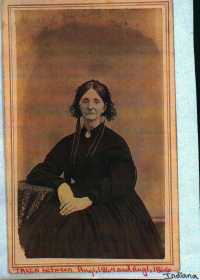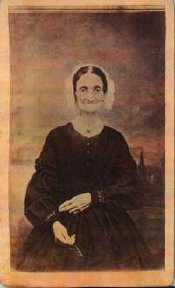Sign up for the Family Tree Newsletter Plus, you’ll receive our 10 Essential Genealogy Research Forms PDF as a special thank you!
Get Your Free Genealogy Forms
"*" indicates required fields
 |
 |
| Figure 1 | Figure 2 |
Mimi Malcolm’s children call these two women “bony hands” based on the enlarged joints of the woman in Figure 2. Mimi would like to know if these two women are the same person: Mary C. (Wilder) Homes (1799-1875).
On the back of Figure 1, there is a 2-cent stamp, also known as a revenue stamp. This is a very helpful clue for dating an image. On Aug. 1, 1864, the United States government levied a tax on photographs and continued to do so for two years. This stamp indicates when the picture was taken, but the denomination of the stamp also tells you the cost of the image. For instance, the 2-cent stamped picture sold for less than 25 cents, while a 3-cent stamped image cost between 25 and 50 cents and a nickel meant the image cost 50 cents to $1.
Since photographers were required to hand-cancel each picture, most feature the name or initials and the date of sale. By checking the back of Figure 1 with a magnifying glass, Mimi Malcolm should be able to determine an exact date for the photograph.
The style of these two images also reveals dating clues. Cartes de visites were quite popular in the mid-19th century. They were small enough (2×4 inches) to be presented when visiting friends and collected in photograph albums. The card stock, color, border and pose all indicate a time frame for these images. There are detailed explanations of card thickness and style in William C. Darrah’s Cartes de Visite in 19th Century Photography (Darrah-Smith Books). The double line around the image in Figure 1 suggests the picture was taken from 1861 to 1869, a time frame that agrees with the revenue stamp. According to Darrah, the portrait of the seated older woman dates from 1860-1866 because it is on a plain card without a revenue stamp or border.
Mimi Malcolm specifically asked whether these two women were the same person and based on the style of photograph, exterior clues and poses, the answer is no. Since there is a family resemblance between the two women, it is possible that they are related—perhaps mother and daughter. It is likely that one of these women is Mary (Wilder) Homes, but it is difficult to determine which one appears to be in her 60s. It all depends on the aging patterns of women in that family. The older woman appears to be elderly due to several factors. The appearance of her lower face suggests that she is missing several teeth—not an uncommon phenomena in the mid-19th century. Her hands with their enlarged joints could be a sign of age or arthritis. She is also holding a pair of glasses in her right hand. The younger woman could be a recent widow, based on her all-black attire including cap and appears to be around the right age to be Mary (Wilder) Homes.
As with all photo identifications, it may never be possible to positively identify these two women. I would start by re-examining the family history to see if Mary Wilder’s mother was still living in the 1860s. This may help clarify the relationship between the two women.
ADVERTISEMENT

